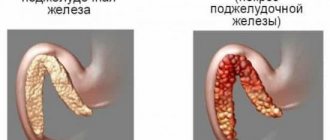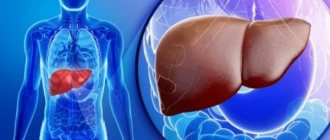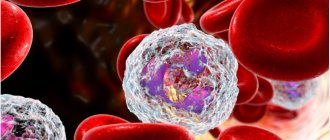Amylases are a group of enzymes that are responsible for the body's breakdown of carbohydrates from food.
Amylase is produced by the salivary glands (S-type amylase) and the pancreas (pancreatic or P-amylase); in addition, a small amount of the enzyme is synthesized in the mucosa of the small intestine, ovaries, liver and placenta during pregnancy. In diseases of the pancreas or in cases of impaired outflow of pancreatic juice, the level of pancreatic amylase in the blood increases, while the concentration of salivary amylase does not change.
Acute pancreatitis is the most common cause of increased pancreatic amylase, which makes the pancreatic amylase test one of the necessary laboratory tests for diagnosing this disease. Typically, a pancreatic amylase test is prescribed together with a lipase test. In some cases, the cause of increased blood P-amylase in the absence of pancreatic diseases may be macroamylasemia, a condition in which amylase combines with large protein molecules in the blood serum and cannot be excreted in a timely manner by the kidneys. That is, the increase in the indicator in the blood occurs due to a decrease in the rate of its elimination from the body.
With reduced function or after removal of the pancreas, as well as with cystic fibrosis, a decrease in the amount of pancreatic amylase in the blood is observed.
When is laboratory diagnostics necessary?
α-amylase is included in the list of indicators to be assessed as part of a biochemical blood test. This is a method of laboratory research of the physical properties and chemical composition of blood, which allows one to assess the functionality of internal organs and identify possible disorders.
The analysis is prescribed:
- for symptomatic patient complaints;
- for prevention purposes;
- to control the therapy.
The main direction of research into the digestive enzyme (pancreatic amylase) is the timely diagnosis and control of treatment of pancreatic diseases. Emergency diagnostics of alpha-amylase levels is carried out if:
- for acute inflammation of the pancreas (acute pancreatitis);
- inflammation of the serous covering of the peritoneum (peritonitis);
- ectopic pregnancy.
Important! With a high level of α-amylase in the blood against the background of acute pain in the left abdomen, radiating to the left clavicle and lower back, nausea and vomiting, accompanied by low-grade body temperature (37–38 °C), acute pancreatitis is 100% diagnosed.
Regular blood microscopy to determine the level of alpha-amylase is necessary for diabetics, patients with chronic pathologies of the pancreas and liver, and cancer patients. The blood sampling procedure is carried out in a laboratory, in the morning, and strictly on an empty stomach. To obtain objective final data, the patient is recommended to:
- three days before the analysis, eliminate fatty foods, hot seasonings and spices, and alcoholic beverages from the diet;
- stop taking medications (diuretics, enzymatic, hormone-containing, non-steroidal anti-inflammatory drugs);
- On the eve of the procedure, limit sports and other physical activities.
The duration of fasting before the study is 8–12 hours.
General information
The enzyme is a component of pancreatic juice and is responsible for the breakdown of carbohydrates. The concentration of the enzyme in the blood is normally low. Pancreatic juice enters the duodenum and is involved in the process of food digestion. The presence of the enzyme in the blood is normally explained by the renewal of the cells in which it is contained. The release of amylase into the blood in large quantities is most often caused by a blockage of the pancreatic duct (for example, a tumor or stones) or significant damage to the pancreas.
This test is of high importance in the diagnosis of pancreatitis
and a number of other diseases in which the pancreas is involved in the pathological process. It is often prescribed in conjunction with a blood test for lipase (an enzyme that is responsible for the breakdown of fats). Also, the test results are used to monitor the condition of patients with cancer that affects the pancreas; assessing the results of surgical intervention.
Decoding the results
The norm of total amylase is 28-100 U/l. The pancreatic enzyme concentration is interpreted in relation to the total amount of amylase. The most common cause of elevated readings is pancreatitis. In acute illness, values can exceed the norm by 6-10 or more times. It remains high for 3-5 days. If the readings are several times higher than normal, the pain is most likely caused by damage to the pancreas. It must be taken into account that in some patients with acute pancreatitis, enzyme activity remains within normal limits or increases slightly. The severity of the disease cannot be judged from the results of this test. For example, if most of the cells that produce the enzyme die, its activity remains within normal limits. With a chronic disease, the indicators first increase and then gradually decrease. Most often, chronic disease develops in alcoholics. An increase in the amount of the enzyme can be explained by other reasons (for example, pancreatic malignancy, peritonitis, pregnancy).
A decrease in the amount of the enzyme is observed in patients with high cholesterol, severe hepatitis, decreased pancreatic functionality, and cystic fibrosis. To obtain an interpretation of the results and further recommendations, you should consult a doctor. In many cases, if indicators are violated, the patient requires immediate medical attention. Self-medication is unacceptable, as it can cause irreversible pathological changes in the body.
Reasons for low performance
Low amylase levels are not abnormal in young children. Due to the characteristics of the baby’s diet and digestive system, a small amount of pancreatic enzyme is sufficient. The main part of amylase is found in the baby's salivary glands, helping him to fully absorb breast milk.
The activity of amylase and other digestive enzymes may be reduced in children due to the severe congenital pathology of muscovidesis. The disease is characterized by dysfunction of the exocrine glands and the functioning of the digestive and respiratory organs. The cause of the disease is the inheritance of damaged genes from both parents (autosomal recessive inheritance). Infants in the first year of life with this diagnosis have an extremely unfavorable prognosis.
A pathological abnormality associated with enzyme deficiency is fermentopathy. The disease may be congenital or acquired. In the first case, the decisive factor in the occurrence of digestive abnormalities is a genetic cause. In the second, stable eating disorders or chronic pathologies of the gastrointestinal tract (gastrointestinal tract).
Other reasons for decreased alpha-amylase concentrations are associated with diseases of the hepatobiliary system:
- Irreversible transformation of hepatocytes (liver cells) into connective tissue – cirrhosis. By nature of origin it can be viral, alcoholic, metabolic and nutritional.
- Chronic inflammatory liver damage - hepatitis. The chronic form develops as a result of incorrect therapy or patient violation of the rules for treating viral hepatitis A, B, C.
Deviations in the analysis parameters are observed in case of mechanical damage (tissue rupture, blood vessels, bruises, wounds, etc.) of the digestive system. The level of alpha-amylase in this case can be either lower than normal or higher. Reduced enzyme activity is recorded in the postoperative period in patients who have undergone surgery on the abdominal organs.
The most common reason is partial resection or complete removal of the pancreas (pancreatectomy). Another cause of enzyme deficiency is extreme pancreatitis, characterized by the death of pancreatic cells - pancreatic necrosis. The degeneration of cells and tissues of the body, with the loss of the ability to produce biologically active substances, accompanies cancer. In severe stages of cancer, the synthesis of enzymes, hormones, etc. decreases or completely stops.
The only treatment for pancreatic necrosis is pancreatic necrectomy
A rare pathology in which the concentration of amylase is disrupted is benign macroamylasemia (an abnormal combination of enzyme molecules with other blood molecules). A low level of α-amylase in the blood of women during pregnancy characterizes toxicosis of pregnant women.
With insufficient production of alpha-amylase, overactivity of the thyroid gland often occurs - hyperthyroidism or excess production of hormones. Regardless of the reason, a lack of an enzyme inhibits the full functioning of the digestive organs. The body is not able to properly process and absorb nutrients (fats, proteins, carbohydrates). Metabolism is disrupted, diseases of the gastrointestinal tract and endocrine system progress.
Results
Alpha amylase is an essential digestive enzyme synthesized by the pancreas and salivary glands. The concentration of the substance in the body is determined through a biochemical analysis of blood and urine. If the values decrease below the reference values, the doctor may suspect the development of liver pathologies and hyperthyroidism. In children, the cause of the disorder is genetic pathologies of enzyme production (muscovidosis, enzymopathy).
The lower limit of normal for adult men and women of reproductive age is considered to be 25 units/l. (top – 125 units/l). In children, normative indicators depend on age. If the indicators change in one direction or another, it is necessary to undergo additional diagnostics, including laboratory tests and hardware procedures (ultrasound, MRI, CT, etc.).











